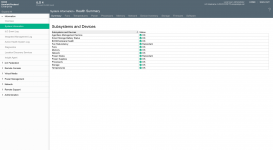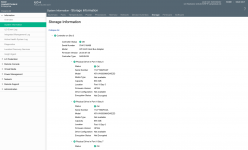Hi!
I'm running TrueNAS Scale on a HPE Microserver Gen10+. The iLO5 BMC on the system can integrate with a client-side service called AMS (Agentless Management Service) in order to pass some client OS information through to the iLO gui. Things like networking config and SATA drive info. AMS is available as an Ubuntu package containing the amsd daemon and the systemd config files to run it. Out of curiosity and not necessity, I am trying to run the amsd daemon on my system.
I have tried two things so far: running AMSD in a docker container and running in an Ubuntu VM.
The docker approach looks like this:
Launch the container interactively for testing, and try to start amsd to see if it works:
The daemon starts, but it's not able to access SMBIOS from inside the container.
For the VM approach, I created a normal Ubuntu 20.04 VM and ran the same commands as in the Dockerfile above to install the amsd daemon. Launching it inside the VM I get a different result:
So in this case the BMC is not visible from inside the VM.
A third approach would be to install and run amsd directly on the TrueNAS Debian system. I think this would work at least temporarily but I have not tried it since it is not the intended usage scenario for running services on TrueNAS. My favored approach would be to get it working as a docker container and eventually publish to TrueCharts so that other Microserver users can install it with one click.
Any ideas?
Thanks,
Andrew
I'm running TrueNAS Scale on a HPE Microserver Gen10+. The iLO5 BMC on the system can integrate with a client-side service called AMS (Agentless Management Service) in order to pass some client OS information through to the iLO gui. Things like networking config and SATA drive info. AMS is available as an Ubuntu package containing the amsd daemon and the systemd config files to run it. Out of curiosity and not necessity, I am trying to run the amsd daemon on my system.
I have tried two things so far: running AMSD in a docker container and running in an Ubuntu VM.
The docker approach looks like this:
Code:
FROM ubuntu:20.04 RUN apt-get update && apt install -y curl gnupg RUN echo "deb http://downloads.linux.hpe.com/SDR/repo/mcp focal/current non-free" > /etc/apt/sources.list.d/mcp.list RUN curl http://downloads.linux.hpe.com/SDR/hpPublicKey1024.pub | apt-key add - RUN curl http://downloads.linux.hpe.com/SDR/hpPublicKey2048.pub | apt-key add - RUN curl http://downloads.linux.hpe.com/SDR/hpPublicKey2048_key1.pub | apt-key add - RUN curl http://downloads.linux.hpe.com/SDR/hpePublicKey2048_key1.pub | apt-key add - RUN apt-get update && apt install -y amsd && rm -rf /var/lib/apt/lists/*
Launch the container interactively for testing, and try to start amsd to see if it works:
Code:
# docker build --network=host -t amihal/ams . # docker run --device /dev/mem --cap-add SYS_RAWIO -i -t amihal/ams bash root@79964ccb4e69:/# amsd SM BIOS initialization failed, unable to determine system type
The daemon starts, but it's not able to access SMBIOS from inside the container.
For the VM approach, I created a normal Ubuntu 20.04 VM and ran the same commands as in the Dockerfile above to install the amsd daemon. Launching it inside the VM I get a different result:
Code:
ubuntu-mate@ubuntu-mate:~$ sudo amsd This program requires the host to have a HP Integrated Lights Out 4/5 (iLO 4 or iLO 5) BMC
So in this case the BMC is not visible from inside the VM.
A third approach would be to install and run amsd directly on the TrueNAS Debian system. I think this would work at least temporarily but I have not tried it since it is not the intended usage scenario for running services on TrueNAS. My favored approach would be to get it working as a docker container and eventually publish to TrueCharts so that other Microserver users can install it with one click.
Any ideas?
Thanks,
Andrew


